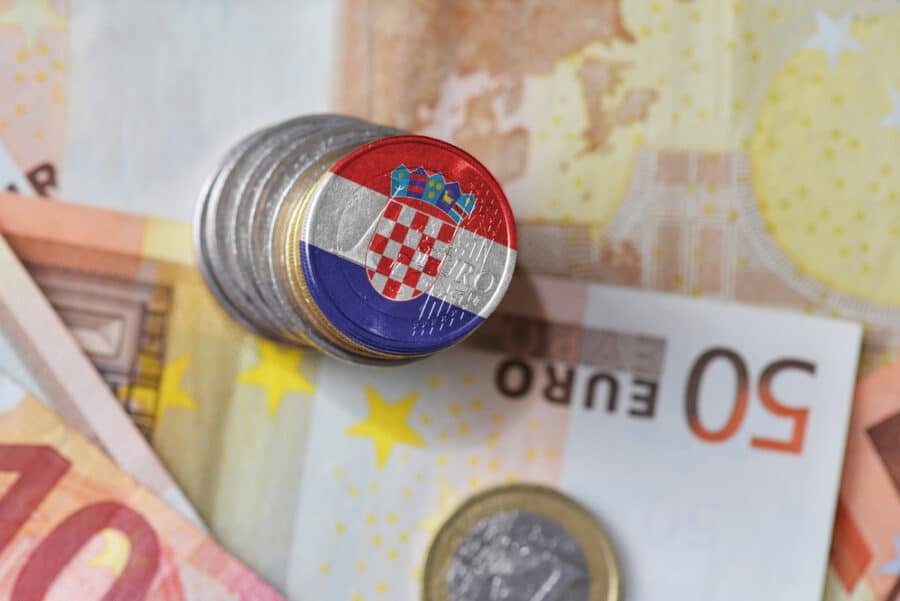Here is a complete list of the 25 countries that use the euro, the official currency of the European Union. This guide has many euro-related facts and interesting information on the European currency, such as who is a part of the eurozone and which EU nations still are not.

Are you planning a trip to Europe in 2025 and want to know what currency you need? Or do you want to keep up-to-date with the latest global financial trends? If so, then this post is for you!
I live in Croatia, which became one of the eurozone countries in 2023. After the introduction of the euro was shocked to learn how many countries use the euro after its introduction.
The euro has become one of the most widely used currencies in the world, and knowing which countries are using the euro can be incredibly useful.
In this article, we’ll give you a complete list of all the countries that currently use the euro and provide some valuable insights into what this means for travelers, investors, and more. So grab a cup of coffee, sit back, and read on – because by the end of this post, you’ll be an expert on everything euro-related!
Skip Ahead To My Advice Here!
Euros – What Are They

The euro is the official currency of 20 out of 27 European Union member countries. It was introduced in 1999 and has since grown to be one of the world’s most traded currencies. Countries that use the euro are called the eurozone.
When the euro was first created, it was only used by 12 countries.
Austria, Belgium, Finland, France, Germany, Greece, Ireland, Italy, Luxembourg, Netherlands, Portugal, and Spain all adopted the euro as their official currency in January 1999. Slovenia joined in 2007, Cyprus and Malta in 2008, Slovakia in 2009, Estonia in 2011, Latvia in 2014, Lithuania in 2015, and Croatia in 2023.
There are currently 20 European Union member countries that use the euro as their currency: Austria, Belgium, Croatia, Cyprus, Estonia, Finland, France, Germany, Greece, Ireland, Italy*, Latvia, Lithuania, Luxembourg, Malta, Netherlands, Portugal, Slovakia, Slovenia and Spain.
When Was Euro First Used? And By Which Country
The euro was first used in 1999 when eleven European Union member states introduced it. These countries were Austria, Belgium, Finland, France, Germany, Ireland, Italy, Luxembourg, the Netherlands, Portugal, and Spain. Greece later joined in 2001.
List Of European Countries Using The Euro

As of January 2023, there are 20 EU member countries that use the euro as their official currency. Croatia was the most recent member of the EU to join joined in January 2023.
- Austria
- Belgium
- Croatia
- Cyprus
- Estonia
- Finland
- France
- Germany
- Greece
- Ireland
- Italy
- Latvia
- Lithuania
- Luxembourg
- Malta
- Netherlands
- Portugal
- Slovakia
- Slovenia
- Spain
Brands We Use And Trust
List Of Non-EU Countries Using The Euro
There are a number of countries that use the euro as their currency but are not members of the European Union.
- Andorra
- Kosovo
- Monaco
- Montenegro
- San Marino
- Vatican City
Map Of Countries That Use The Euro
- Kosovo declared independence from Serbia in 2008 and is not recognized as an independent state by five UN member states. It uses the euro as its official currency pursuant to an International Monetary Fund arrangement
- Monaco and San Marino have customs union agreements with the EU whereby they use EU VAT rates, and exchange control regulations apply. Both countries mint their own coins with designs similar to those of the euro coins used in other countries
- Montenegro has been using the euro since 2002
- The Vatican City has a special agreement with the EU whereby it uses euros as its official currency and receives an annual subsidy from the EU budget
What Countries Are Part Of The European Union (EU)
There are 27 member states of the European Union. These countries are Austria, Belgium, Bulgaria, Croatia, Cyprus, the Czech Republic, Denmark, Estonia, Finland, France, Germany, Greece, Hungary, Ireland, Italy, Latvia, Lithuania, Luxembourg, Malta, the Netherlands, Poland, Portugal, Romania, Slovakia, Slovenia, Spain, and Sweden.
The euro is the official currency of 20 of these 27 member states. The other seven member states have chosen to keep their own national currencies and have not yet adopted the euro. These countries are Bulgaria, Czech Republic, Denmark, Hungary, Poland, Ro, mania, and Sweden.
Why Are Some Countries In The EU Not Using The Euro As The Currency – Who Are They

There are several reasons why some EU countries have not adopted the euro as their currency. Some of these countries, like Denmark, have opt-outs from the monetary union. Other countries, like Sweden, have chosen not to join the euro zone despite being eligible to do so.
Some countries have not adopted the euro because they believe it would be detrimental to their economies.
These countries are concerned that they would lose control over their monetary policy and interest rates if they adopted the euro. Additionally, many of these countries have strong economies and don’t feel pressure to switch to the euro. For example, Sweden has one of the strongest economies in Europe, and its currency, the SweKronakrona, is very stable.
So far, only 20 out of 27 EU member states have adopted the euro as their currency. This means that there are still 7 EU countries that are using their own national currencies. These include:
- Bulgaria
- Czech Republic
- Denmark
- Hungary
- Poland
- Romania
- Sweden
What Country Will Next Adopt The Euro As The Local Currency
This is a difficult question to answer, as many factors need to be considered before a country can adopt the euro as its local currency. Some of these factors include:
- The country’s economic stability
- The country’s political stability
- The country’s inflation rate
- The country’s trade deficit or surplus
- The country’s interest rates
There is no definite answer as to which country will be the next to adopt the euro as its local currency. However, it is believed that it would next be Bulgaria. The euro is targeted to be introduced in January 2025, leaving behind the “Lev,” making the euro Bulgaria’s second currency after more than 140 years.
What Country Will Next Join The European Union (EU)

The next country to join the European Union is widely expected to be North Macedonia. This follows the recent signing of the Prespa agreement between Greece and North Macedonia, which settled a long-standing dispute over the latter’s name.
Other potential candidates for EU membership include Albania, Bosnia and Herzegovina, Kosovo, Montenegro, Serbia, and Turkey. All these countries are currently in various stages of negotiations or pre-accession processes with the EU.
What Are The Denominations Of The Euro
Euro banknotes are in denominations of 5, 10, 20, 50, 100, 200, and 500.
There are also 1 and 2 euro coins, as well as euro cents in coins of 1, 2, 5, 10, 20, and 50.
Euro & Eurozone FAQs
What are some of the countries in the Eurozone?
Some of the countries in the Eurozone include Germany, France, Italy, Spain, Greece, Portugal, Belgium, the Netherlands, Austria, Ireland, and many others.
Do all European Union member states use the euro?
No, not all European Union member states use the euro. Some countries have opted to retain their own national currencies.
Is the euro symbol the same in all countries using the currency?
Yes, the euro symbol (€) is the same in all countries using the currency. It represents the euro as a single currency across the Eurozone.
Can I use the euro in countries outside of the Eurozone?
While the euro is not the official currency in countries outside of the Eurozone, some countries and territories accept the euro as a form of payment, especially in popular tourist areas or border regions.
Is the euro widely accepted in European airports and major cities?
Yes, the euro is widely accepted in European airports and major cities, especially in countries that are popular tourist destinations. However, it’s always a good idea to have some local currency on hand.
Can I exchange euro coins and euro banknotes in any European country?
Yes, you can generally exchange euro coins and banknotes in any European country that uses the euro as its official currency. Banks, currency exchange offices, and some post offices typically offer currency exchange services.
Can I use U.S Dollar or Pound Sterling in Europe?
While the euro is the preferred currency in most of Europe, major tourist destinations and larger cities might accept the United States Dollar. However, it’s not widely accepted, and you’ll get a better exchange rate using euros. It’s advisable to exchange your US dollar for other foreign currency for euros or use a credit card for payments.
Is the Euro Currency the most traded in the world?
No. The U.S. dollar (USD) is the first-most-traded currency in the world. While the euro (EUR) is the second-most-traded currency globallty.
Now that you have this list of countries that use the euro – which countries will you visit in 2025?


I am collector of the euro currency coins
Please can you send me a list of all the countries using the euro
Currency and the year in which each country starts using
The euro curency, the problem is that on one site i found
The year and on another site i will find different yeae for the
Same country, so please sir can you help me
Thank you in advance
Regards.
Joseph
Montenegro has been using the Euro since…when? The sentence was left incomplete. Was it also in 2018, since they started to issue their own coins?
Yikes, what a dumb thing for me to miss. That should have said since “2002”.
Are you sure Croatia uses the euro, I used kuna there on my trip.
Yes, 100%. I live in Croatia, and we switched to the euro in 2023.